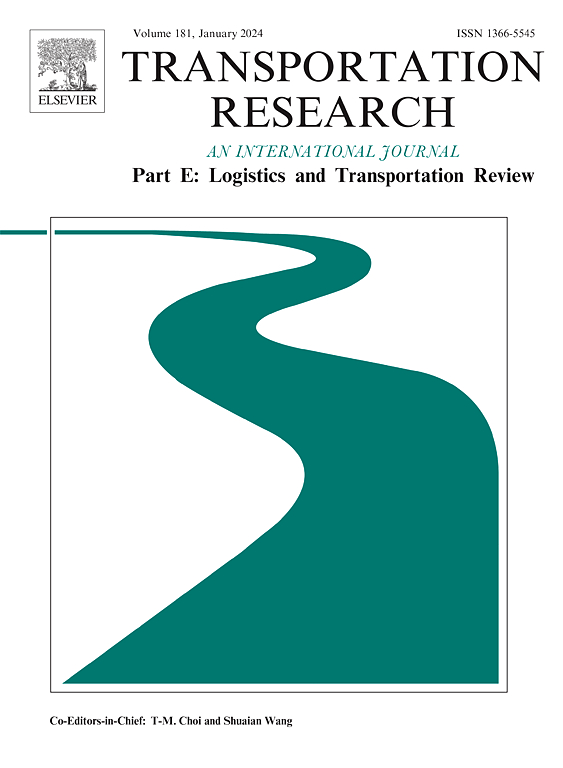Cooperative strategy selection for livestreaming commerce supply chain with network externality
IF 8.8
1区 工程技术
Q1 ECONOMICS
Transportation Research Part E-Logistics and Transportation Review
Pub Date : 2025-08-05
DOI:10.1016/j.tre.2025.104352
引用次数: 0
Abstract
In the ever-evolving landscape of livestreaming commerce, brands (proposing service requirements) and platforms (providing technical and operational support) serve as core collaborative entities facing two-way challenges: brands are constrained by high service costs and operational inexperience, while platforms encounter flow bottlenecks due to insufficient brand service capabilities. This dual challenge requires both parties to collaboratively design cooperation strategies to achieve value co-creation. We apply the Stackelberg Model and Nash Bargaining Model to characterize three cooperation strategies between brands and platforms, namely Simple Cooperation (SPC), Operational Support (OS), and Strategic Cooperation (STC), then analyze the solutions in different scenarios. By integrating fan economy and herd behavior into game-theoretic frameworks, we conduct decision analysis. First, our results show that compared with SPC, both STC and OS can lead to Pareto improvement. Second, when platforms have strong bargaining power and market conditions are sluggish, both parties opt for OS as the equilibrium strategy. Third, STC is optimal when brands and platforms have comparable bargaining power in flourishing markets. Especially as market conditions change, STC can effectively adjust the retail price and stimulate the brand to invest. Three extensions based on revenue sharing and cost sharing mechanisms validate the robustness of the findings. Our research comprehensively investigates the impacts of network externality, livestreaming services, and negotiation power on optimal strategic choices, presenting a robust decision framework that offers practical guidance for the livestreaming commerce ecosystem to foster collaborative growth.
具有网络外部性的直播商务供应链合作策略选择
在不断变化的直播商业格局中,品牌(提出服务需求)和平台(提供技术和运营支持)作为核心协作实体,面临着双向挑战:品牌受服务成本高、运营经验不足的制约,平台因品牌服务能力不足而遇到流量瓶颈。这一双重挑战要求双方共同设计合作策略,实现价值共创。运用Stackelberg模型和纳什议价模型对品牌与平台之间的简单合作(SPC)、运营支持(OS)和战略合作(STC)三种合作策略进行了表征,并分析了不同场景下的解决方案。通过将粉丝经济和从众行为整合到博弈论框架中,进行决策分析。首先,我们的研究结果表明,与SPC相比,STC和OS都可以导致Pareto改进。第二,当平台议价能力较强,市场条件低迷时,双方都选择操作系统作为均衡策略。第三,当品牌和平台在繁荣市场中具有相当的议价能力时,STC是最优的。特别是随着市场情况的变化,STC可以有效地调整零售价格,刺激品牌投资。基于收入共享和成本共享机制的三个扩展验证了研究结果的稳健性。我们的研究全面调查了网络外部性、直播服务和谈判能力对最优战略选择的影响,提出了一个强大的决策框架,为直播商业生态系统促进协同增长提供了实用指导。
本文章由计算机程序翻译,如有差异,请以英文原文为准。
求助全文
约1分钟内获得全文
求助全文
来源期刊
CiteScore
16.20
自引率
16.00%
发文量
285
审稿时长
62 days
期刊介绍:
Transportation Research Part E: Logistics and Transportation Review is a reputable journal that publishes high-quality articles covering a wide range of topics in the field of logistics and transportation research. The journal welcomes submissions on various subjects, including transport economics, transport infrastructure and investment appraisal, evaluation of public policies related to transportation, empirical and analytical studies of logistics management practices and performance, logistics and operations models, and logistics and supply chain management.
Part E aims to provide informative and well-researched articles that contribute to the understanding and advancement of the field. The content of the journal is complementary to other prestigious journals in transportation research, such as Transportation Research Part A: Policy and Practice, Part B: Methodological, Part C: Emerging Technologies, Part D: Transport and Environment, and Part F: Traffic Psychology and Behaviour. Together, these journals form a comprehensive and cohesive reference for current research in transportation science.

 求助内容:
求助内容: 应助结果提醒方式:
应助结果提醒方式:


